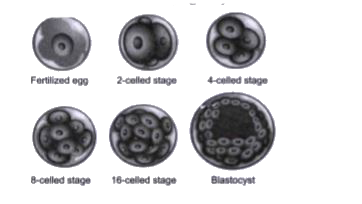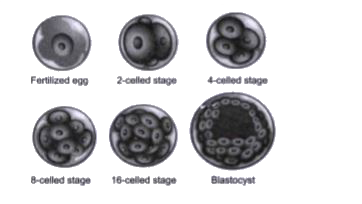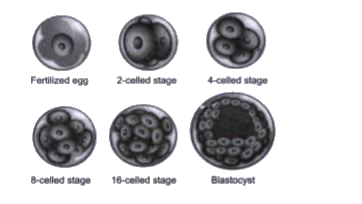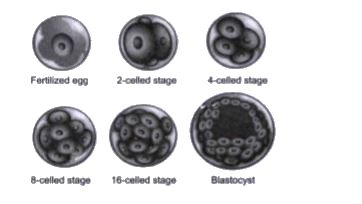A blastula consisting of a blastoderm of one or several layers of cells arranged around a spacious blastocoel is termed as
Periblastula
Coeloblastula
Stereoblastula
Discoblastula
To solve the question regarding the type of blastula consisting of a blastoderm of one or several layers of cells arranged around a spacious blastocoel, we can analyze the provided options step by step.
1. Understanding the Question: The question asks for a specific type of blastula characterized by a blastoderm surrounding a spacious blastocoel.
2. Analyzing the Options:
- Option A: Periblastula: This type of blastula is formed from centrolichthal eggs through superficial segmentation. It typically has a single layer of epithelial cells surrounding a centrally placed yolk and does not have a blastocoel. Therefore, this option is incorrect.
- Option B: Coeloblastula: This blastula is formed through coloblastic cleavage, resulting in a hollow, ciliated, spherical structure. It is typical in echinoderms. However, it does not match the description of having a spacious blastocoel. Thus, this option is also incorrect.
- Option C: Stereoblastula: This type of blastula arises from spiral cleavage and is characterized by the absence of a blastocoel, making it a solid blastula. It is found in molluscs. Hence, this option is incorrect as well.
- Option D: Discoblastula: This blastula is formed by partial cleavage in a fertilized ovum with a large amount of yolk. It develops from a blastodisc and consists of a cellular cap (blastoderm) that is separated from the uncleaved yolk mass by a small cavity known as the blastocoel. This matches the description given in the question.
3. Conclusion: Based on the analysis of the options, the correct answer is Discoblastula. This type of blastula consists of a blastoderm of one or several layers of cells arranged around a spacious blastocoel.
Final Answer:
The correct answer is Discoblastula.
- Option A: Periblastula: This type of blastula is formed from centrolichthal eggs through superficial segmentation. It typically has a single layer of epithelial cells surrounding a centrally placed yolk and does not have a blastocoel. Therefore, this option is incorrect.
- Option B: Coeloblastula: This blastula is formed through coloblastic cleavage, resulting in a hollow, ciliated, spherical structure. It is typical in echinoderms. However, it does not match the description of having a spacious blastocoel. Thus, this option is also incorrect.
- Option C: Stereoblastula: This type of blastula arises from spiral cleavage and is characterized by the absence of a blastocoel, making it a solid blastula. It is found in molluscs. Hence, this option is incorrect as well.
- Option D: Discoblastula: This blastula is formed by partial cleavage in a fertilized ovum with a large amount of yolk. It develops from a blastodisc and consists of a cellular cap (blastoderm) that is separated from the uncleaved yolk mass by a small cavity known as the blastocoel. This matches the description given in the question.
The correct answer is Discoblastula.
Topper's Solved these Questions
- HUMAN REPRODUCTION BOOK - CENGAGE BIOLOGY ENGLISHCHAPTER - HUMAN REPRODUCTION EXERCISE - Assertion -Reasoning Question
16 Videos
- HUMAN HEALTH AND DISEASEBOOK - CENGAGE BIOLOGY ENGLISHCHAPTER - HUMAN HEALTH AND DISEASEEXERCISE - ARCHIVES
46 Videos
- MICROBES IN HUMAN WELFAREBOOK - CENGAGE BIOLOGY ENGLISHCHAPTER - MICROBES IN HUMAN WELFAREEXERCISE - ARCHIVES
26 Videos
Similar Questions
Knowledge Check
Cleavage is the series of rapid mitotic divisions in zygote and forms blastula. The 2, 4, 8, 16 daughter cells are called blastomere. Embryo with 64 blastomere is known as blastocyst and has blastocoel cavity. Blastocyst gets implanted in uterine wall and leads to pregnancy.

Solid mass of cells with 16 blastomere is called:AMorulaBBlastulaCGastrulaDZygoteCleavage is the series of rapid mitotic divisions in zygote and forms blastula. The 2, 4, 8, 16 daughter cells are called blastomere. Embryo with 64 blastomere is known as blastocyst and has blastocoel cavity. Blastocyst gets implanted in uterine wall and leads to pregnancy.

Correct sequence of various structures formed during embryonic development:AMorula → Embryo → Gastrula → BlastulaBZygote → Embryo → Morula → BlastulaCBlastula → Morula → Gastrula → ZygoteDZygote → Morula → Blastula → GastrulaCleavage is the series of rapid mitotic divisions in zygote and forms blastula. The 2, 4, 8, 16 daughter cells are called blastomere. Embryo with 64 blastomere is known as blastocyst and has blastocoel cavity. Blastocyst gets implanted in uterine wall and leads to pregnancy.

Site of implantation is:AEndometrium of uterusBCervixCUterine fundusDInfundibulum of oviduct
Read the following statements.
A. Cartilage is present in between atlas and axis.
B. In epithelium, cells are compactly arranged with the little intercellular matrix.
C. The simple epithemlium consists of a two or more layer of cells.
How many of the above statement are incorrect ?
View SolutionRead the following characteristics (I - IV) and identify the structure to which these features correspond
I. Cortex is made up of several layers of thin walled parenchyma cells without any intercellular spaces.
II Endoderm is made up of a single layer of barrel - shaped cells without any intercellular spaces.
III . Few layers of thick - walled parenachymatous cell forms pericycle.
IV. Pith is small or inconspicuous.
V. Conjunctive tissue present , and 2 to 4 xylem and phloem patches.
View SolutionThere are 20 persons among whom are two brothers. The number of ways in which we can arrange them around a circle so that there is exactly one person between the two brothers, is
View SolutionCleavage is the series of rapid mitotic divisions in zygote and forms blastula. The 2, 4, 8, 16 daughter cells are called blastomere. Embryo with 64 blastomere is known as blastocyst and has blastocoel cavity. Blastocyst gets implanted in uterine wall and leads to pregnancy.

The cells within the inner cell mass that possess the ability to give rise to the entire organism are called:
View SolutionCleavage is the series of rapid mitotic divisions in zygote and forms blastula. The 2, 4, 8, 16 daughter cells are called blastomere. Embryo with 64 blastomere is known as blastocyst and has blastocoel cavity. Blastocyst gets implanted in uterine wall and leads to pregnancy.

The solid mass of 8-16 cells formed from zygote after successive mitotic division is called:
View Solution
